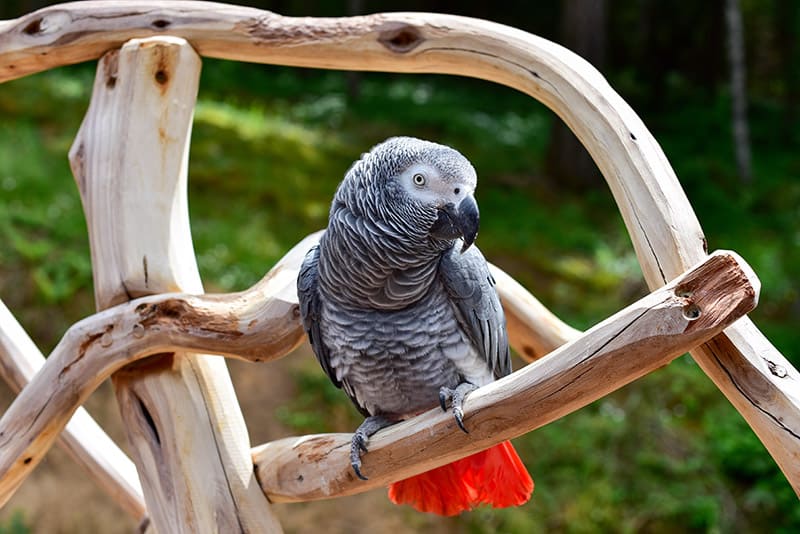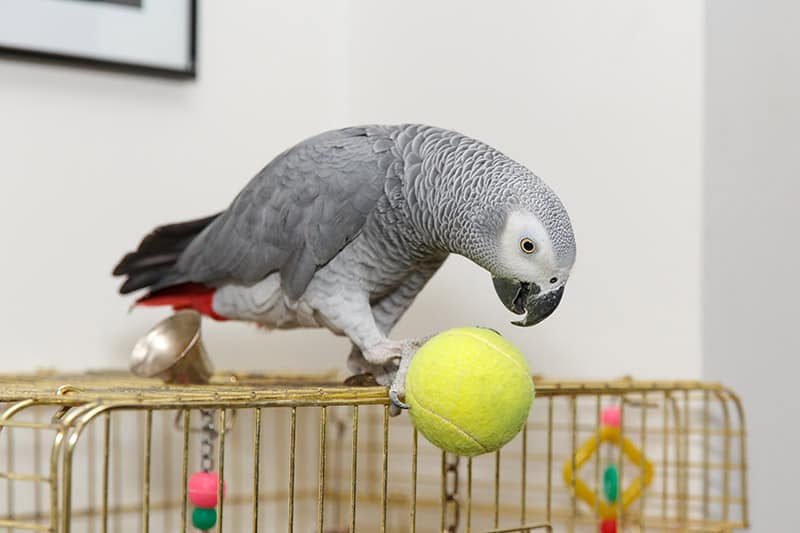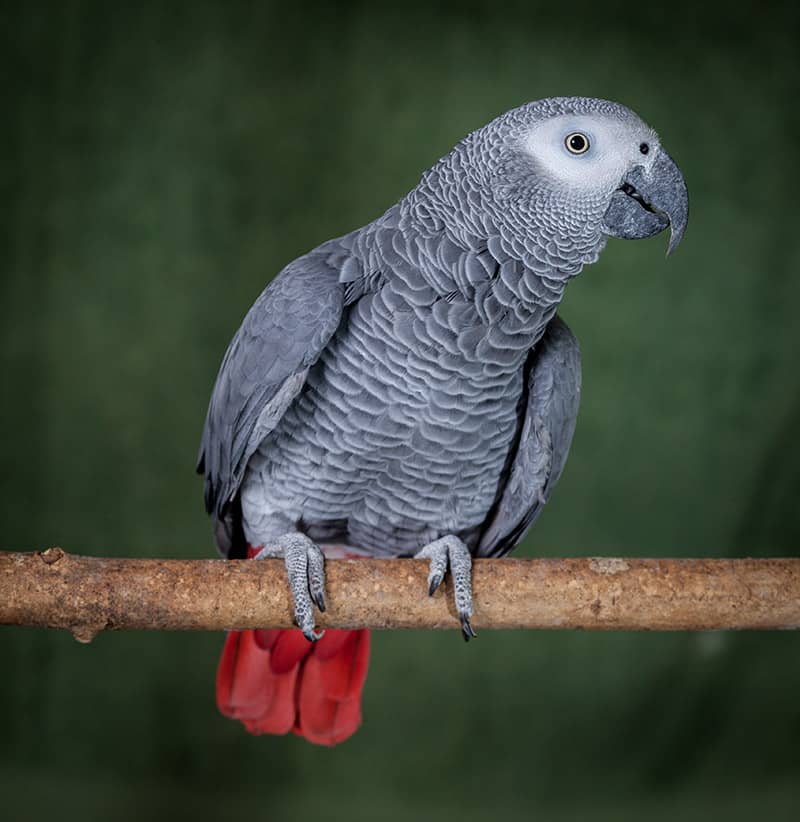The African Grey Congo Parrot Psittacus erithacus is one good looking parrot, and is also said to be one the smartest birds. They are known to be the best talkers in the bird world achieving an unparalleled vocabulary which is extremely articulate. The African Greys can learn 200 or more words and all kinds of tricks. They also frequently imitate the sounds of their environment, including people.
One well-known Grey, N’Ski had a vocabulary of 950 words back in 2004. N’Ski actually greeted Jane Goodall with the words “Got a chimp”, as he had seen pictures of her with her chimpanzees. Once we had an African Grey Congo and a Blue-fronted Amazon at the store. The African grey would ring the phone “ring-ring” and the Blue-fronted amazon would answer with a very cordial “Hello”.
Dr. Irene Pepperberg has worked with and studied these parrots for a number of years. The most notable of these is a grey by the name of Alex. Greys have demonstrated an association of human words with meanings, differentiate colors, and even have concepts of numbers and shapes.
Congo African Greys have a gentle nature over all. Their demeanor, along with the ability to talk and mimics sounds have made them popular pets. Yet keeping them as a pet companion is challenging, and not for everyone. These are long-lived, highly intelligent birds that need a great deal of stimulation to keep from becoming bored.
Greys are often described as having the intelligence of a five year old and the temperament of a two year old. I truly believe they are 3 year olds dressed in feathers. A bored, unstimulated African Grey is prone to developing unpleasant behaviors and even health problems. Problem behaviors like feather plucking are very hard to reverse one they start.
With dedication and care, you can have a happy healthy African Grey Parrot and a great family pet. Getting an African Grey that has been well socialized with people and different situations as a young bird will help ensure a good pet. Provide your grey with a large cage, play areas, and a proper diet. Make sure you give your pet lots of interaction and toys for stimulation.
- To learn more about parrot care in general, see: Bird Care: How to Take Care of a Pet Bird
Scientific Classification
| Kingdom: | Animalia |
| Phylum: | Chordata |
| Class: | Aves |
| Order: | Psittaciformes |
| Family: | Psittacidae |
| Genus: | Psittacus |
| Species: | erithacus |
Scientific Name
Psittacus erithacus
Distribution
The African Grey Parrots Psittacus erithacus are native to various parts of Africa including Kenya, Uganda, Liberia, and islands off the west coast of Africa. The Congo African Grey, the nominate species, is found in the west-central part of Africa mainly within 10 degrees north and south of the equator. In the wild these birds live in flocks of one to two hundred birds.
The two other African Grey subspecies are:
- Timneh African Grey Parrot Psittacus erithacus timneh
This subspecies is also found in the pet market, though not are regularly as the Congo - Psittacus erithacus princeps
This African Grey Parrot only inhabits on the islands of Principe and Gernando Po in the Gulf of Guinea. This bird is darker than the regular African Grey, and is not often found in the trade
To learn more about the African Grey Parrots origins and background, see: African Grey Parrots
Status
The Psittacus erithacus is on the IUCN Red List for Endangered Species as Near Threatened (NT).
Description
The Congo African Grey Parrot Psittacus erithacus was first described by Linnaeus in 1758. It is the best-known of the African Greys and is the nominate species of its genus. This parrot is also known by the common name Red Tailed Grey, and in aviculture its name is shortened to CAG.
The African Grey Congo is gray with a red patch of feathers on the underside of its tail. Occasionally this bird can be seen with some red feathering throughout its body, and this variant is known as the Red Factor Grey. Juveniles have black eyes that become a yellow-cream color by about two years of age.
Congo African Greys vary between 13 – 16″ (32.5 – 40.6 cm) in length from beak to tail, and weigh between 400 – 650 grams. They are somewhat larger than the Timneh African Grey. African Grey parrots are very long-lived and can live 50 or more years in captivity, possibly up to 70 years. They make a nice “jungle” sound when relaxed. When threatened or frightened they make a growling sound.
There has been a lot of work by specialized breeders to develop Grey mutations, utilizing both the Congo and the Timneh African Greys. Varieties developed include red pied, albino, Ino, blue, cinnamon, and more. The most spectacular mutation is a Red African Grey first developed in 1998.

Care and feeding
In the wild, the African Grey Parrots eats seeds, nuts, fruits, and leafy vegetation. These birds will climb around the tree, rather than flying, picking up food and holding it with a foot while eating. They enjoy eating the outer flesh of the oil-palm nut, and have been observed eating snails. In West Africa, with a fondness for grains, it is said they have become rather bold pests attacking the maize fields.
Foods for your pet bird will include a ready-made large hookbill seed mix enriched with vitamins. Their dietary requirements include sources of calcium and Vitamin A. They eat a variety of sprouts, seeds, nuts, fruits, vegetables, and commercial pellets, as well as the same nutritional foods humans eat. A cuttlebone or a calcium block is a good source of calcium.
African Greys should not be fed a diet that is high in fat and protein. A lean diet is recommended as recent studies have indicated heart disease and arteriosclerosis occuring in Greys in their late teens and twenties.
- Fresh vegetables you can offer include mustard greens, green peas, cucumber, young dandelion greens, sweet corn, beet greens, carrots, broccoli, unsprayed lettuce, chickweed, dandelions, eggplant, green peppers, sorrel, spinach leaves, tomatoes and zucchini.
- Fruits that you can offer include, apples, peaches, apricots, bananas, pears, plums, raisons, and most other fruits.
- Avocado and chocolate are considered toxic for birds and sugar and salt should be avoided.
Most parrots enjoy and occasional shower or bath. A shower can be accomplished with either a hand held shower sprayer or a hose with a fine spray head and lukewarm water. A bath pan or ceramic dish 12″-14″ (30-35 cm) can be placed on the bottom of the cage or mounted at about 39″ (1m) above the floor in an aviary.
The wings of parrots should be kept trimmed if you want to discourage flight and to prevent the loss of your pet through an open window or door. However, you must take care to only trim a few (3-5) feathers because this is a heavy-bodied bird, and can be hurt if it falls while taking short flights. The beak and claws need to be trimmed if they are not worn down from climbing and chewing.
Housing
A roomy cage is required, and the bird needs to be let out for regular, extended periods. Make sure the cage is large enough so that a normal-sized Grey keeps from rubbing its tail on the bottom and has plenty of room to extend its wings. Make sure the cage is placed in a well-lighted area free from drafts. Many birds can spend most of their time on a playpen or parrot perch.
Perches should be natural wood ranging in size from 2 – 4 inches in diameter. Various-sized fruit tree branches work very well. Playthings can be such things as climbing ropes, chains, bells, parrot swings and wooden or other destructible bird toys.
An outdoor or breeding aviary needs to have a protected shelter that can be heated and cooled if necessary. It should be no smaller than 4 feet by 6 feet with a floor space of at least 3 feet by 3 feet (1 m x 1 m), be off the ground by 4 feet, and have an attached flight cage. The flight should be 79″ – 118″ (2 – 3 m) long with a perch at each end. A climbing branch and a bird bath are nice additions too.
Maintenance
The basic cage care includes daily cleaning of the water and food dishes. Weekly you should wash all the perches and dirty toys, and the floor should be washed about every other week. A total hosing down and disinfecting of an aviary should be done yearly, replacing anything that needs to be freshened, such as old dishes, toys and perches.
Social Behaviors
The African Grey Congo is a gentle parrot, tamed easily, and they are very sociable. Because of their social nature and their intelligence, their humans become quite devoted to these feathered creatures. Greys in turn love their humans and also get along quite well with other birds in the home. However, they can sometimes become a “one person” bird, often bonding with a person of the opposite sex.
Besides talking, African Greys can and will make all the sounds they hear in the home. They can mimic all the other birds and pets, and of course, they can use any voice that they hear in the house as well. They can begin to mimic even before they are weaned, but not usually in clear sounds for some time. Congo African Greys don’t really start speaking until they are around 2 – 3 years old. As you interact with them, they will talk and associate words with meanings. Many Greys become quite articulate with a large vocabulary, but vocal ability and the inclination to talk may range widely among individual birds. Although they can talk and mimic, they are neither overly noisy nor tend to engage in loud shrieking calls like some of the other vocal parrots.
Despite its wonderful attributes, an African Grey Parrot is not for everyone. A grey is a nervous bird by nature and doesn’t do well with a great deal of commotion, such as a full house of children, dogs, people going in and out, or a great deal of outside noise. They are frequently a one-person bird and will tolerate other members of the household. If there is a great deal of commotion, they will growl or hide.
These parrots require a special human to hold their attention span and keep them from being bored. They need a lot of stimulating toys, 3 to 5 at a time works well, and rotated out with other toys on a regular basis. African Greys are notorious for plucking their feathers if they do not receive enough active stimulation, or enough desired attention from their human.

Handling/Training
African Greys like being handled, but are also perfectly content to just be around the family. They have natural wild instincts still intact so must have supervision and care taken when interacting with people. They are strong birds with a powerful bite and can scratch with their claws. They need strong socialization when young, and then ongoing training to be good members of your family.
You should give a new arrival a few days to get use to you, your voice and its cage before trying to handle it. The Congo African Grey Parrot is somewhat shy and cautious by nature and they need a period of adjustment. They are reserved with new people and objects too, so will tend to sit back and watch before giving of themselves freely. A hand fed baby will not need much taming and can often be handled right away, but be patient and go slow. Allow them to hear your voice, and get used to you and their new environment..
Remember that taming and training a bird takes patience, never ‘punish’ your pet! This only serves to destroy the trust you’ve spent so much time building. For more information on training your African Grey, see Parrots: Handling/Training.
Activities
Exercise and play are important activities for the physical well-being and psychological health of your parrot. These activities help deter distress and prevent the problems like feather picking and biting. Provide your parrot with lots of activities in the form of large link chains, destructible bird toys, bird ladders, parrot swings, ropes, fresh branches for gnawing and chewing, and rotate new bird toys on a regular basis.
Sexual Differences
There is no easily visible means of sexing these birds. If gender identification is important (for example for breeding birds) DNA / Feather or surgical sexing is recommended.
Breeding/Reproduction
In the wild, the Congo African Grey Parrots breeding season is variable. Greys enter into a lifelong monogamous bond when sexually mature. Like macaws, they pick their mates carefully. The pair will show a great deal of devotion and affection to each other in the form of sitting closely and preening. These birds breed in loose colonies, with each pair occupying its own tree.
In captivity, African Grey Congos are easily bred under normal conditions. Grey’s will normally start to breed in their fourth year and they have a very long reproductive life. Because there are so many being bred the price of Congos has been coming down.
When it is time to breed, the male feeds his mate and both will sing soft monotonous notes and perform mating dances where both sexes droop their wings. African Greys will need a deep nest box that is mounted as high up as possible. They do not use any nesting material, but wood blocks should be provided for chewing, which stimulates breeding. The female at this time will sleep in the nest cavity while the male guards it.
The female will lay from 3 to 5 roundish or oval eggs, each one layed at intervals of two to five days. The female settles on the eggs to incubate them and is fed entirely by the male at this point. Incubation lasts 30 days after which the male now stays busy feeding the whole family! The young emerge from the nest at 12 weeks at which time both parents will be feeding them.

Potential Problems
An African Grey Congo that is well cared for will seldom become ill. Though it is often difficult to determine illness, some visible signs of illness to be aware of are:
- ruffled plumage
- listlessness
- drooping wings
- sagging body
- extreme mood changes
- having no appetite
- bulges in feathering
- partially closed or watery eyes
- swelling of the eyelids
- rasping
- difficulty breathing
- excessive saliva
- dirty vent
- any change in the feces not apparently diet related.
Some of the more common illnesses are:
- Psittacosis (chlamydiosis or parrot fever)
- bacterial, viral, or fungal infections
- feather picking (results of boredom, poor diet, sexual frustration, lack of bathing)
- allergies
- chewing flight and tail feathers by juveniles
- beak malformations in chicks
- Papillomas
- kidney disease (gout)
- toxicity
- heavy metal poisoning
- lipomas in older birds.
If you notice any of this bird illnesses in your African Grey, immediately provide a warm, draft free, secure environment kept at about 86°F (30°C). Place food and water close to the perch where it is easily accessible. An ailing parrot should be taken to a avian veterinarian for diagnosis and treatment.
Behavior problems usually stem from something missing in the bird’s environment. Boredom, lack of trust, lack of interaction with other birds or people can lead to problems like biting and feather plucking. Try to develop a bond of trust and spend time with your bird to help avoid these problems.
Availability
The Congo African Grey is readily available. A hand-fed young Congo can be priced anywhere from about $800 to $1200 USD.
Featured Image Credit: kart31, Shutterstock
